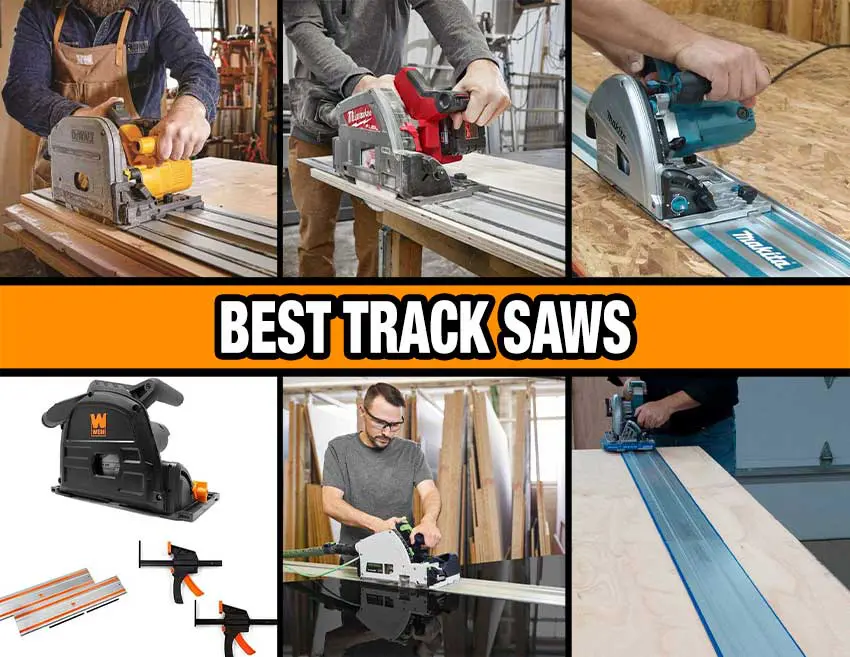People either love their track saw or wish they had one. These tools are incredibly helpful and versatile, allowing users to break down sheet goods, cut slabs into usable sections, and create straight cuts on any large material that is otherwise too unwieldy to run across a table saw. Instead, these saws have tracks that sit on top of the material and the saw that rides along the track, creating a crisp, straight edge.
But not all track saws are equal. In this guide, we’ll go over which track saws you should consider as well as what you need to know to choose the best track saw for your needs.
Our Top Picks
- Best Overall: Festool Plunge Cut Scoring Track Saw TSV 60 KEBQ-F-Plus-FS
↓ Jump to this Saw - Best for the Money: WEN 10-Amp 6.5-Inch Plunge Cut Sidewinder CT1065
↓ Jump to this Saw - Best Cordless: Milwaukee M18 Track Saw Kit 2831-21
↓ Jump to this Saw - Best Track System: Kreg Accu-Cut XL KMA3700
↓ Jump to this Saw
Best Overall
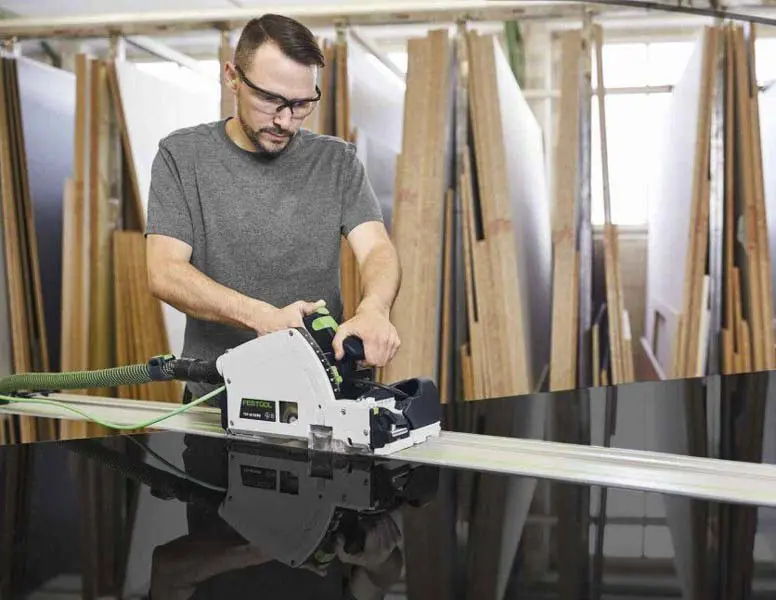
Festool Plunge Cut Scoring Track Saw TSV 60 KEBQ-F-Plus-FS
- Type: Corded
- Power: 1,500W
- Speed: 3,000 RPM (circular); 6,800 (scoring)
Festool has been in the track saw game for almost 45 years, and they’re still going strong. Indeed, we’ve handled plenty of Festool gear, and our experiences have been positive. In this case, they landed our best overall spot with the TSV 60 KEBQ-F-Plus-FS. In the company’s own words, the goal in creating this model was to achieve “the perfect cut.” Naturally, you’re thinking, “What manufacturer doesn’t say that kind of stuff about their products?” But, in all honesty, there’s a lot to like about this unit.
For example, they’ve designed the scoring blades to deliver splinter-free cuts. And, speaking of the scoring blades, you’re looking at speeds of up to 6,800 RPM. But, perhaps most important is the amount of thought that Festool put into the design elements, particularly when it comes to versatility. For one, we like the 60 mm cutting depth. Furthermore, we like certain interface options, such as the ability to manually activate the circular saw and the scoring saw.
Check out our picks for the Best Festool Accessories!
Pros
- Versatile
- 6,800 RPM scoring blade speeds
- 60 mm cutting depth
Cons
- Pricey (but nicely assembled kit)
- 3,000 RPM circular saw blade speed may be a bit on the slow side
Best for the Money
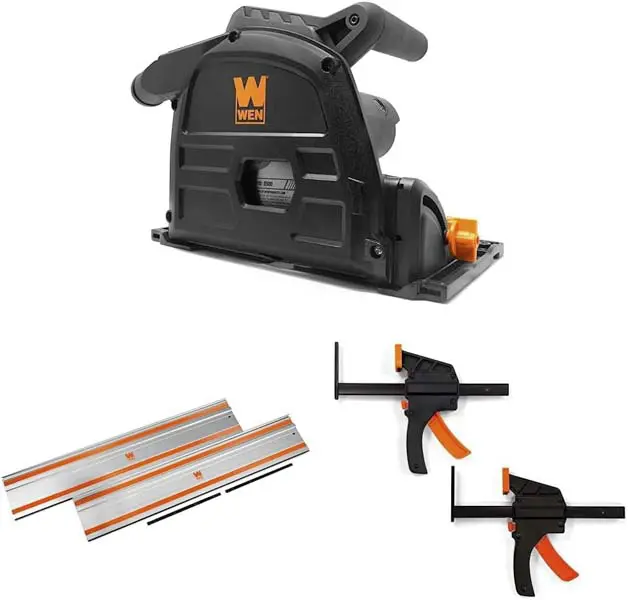
WEN 10-Amp 6.5-Inch Plunge Cut Sidewinder Circular Track Saw CT1065
- Type: Corded
- Power: 10 amp
- Speed: 5,500 RPM
Anyone shopping for the best budget model should consider the WEN CT1065 Sidewinder. This saw features a 10-amp motor that allows it to spin its 6 1/2-inch blade at speeds up to 5,500 RPM. Unfortunately, speeds aren’t adjustable and the 10-amp motor might be slightly undersized, but it can do the trick for most users.
This model offers a very reasonable price tag for everything it comes with. It features the plunge cut saw, two lengths of 55-inch long track that can link together, and two track clamps to keep things secure.
Pros
- Extremely affordable price point
- The top speed of 5,500 RPM is one of the fastest in the group
- Comes with two 55-inch lengths of track and track clamps
Cons
- The speed isn’t adjustable and the 10-amp motor is a little undersized
Best Cordless Track Saw
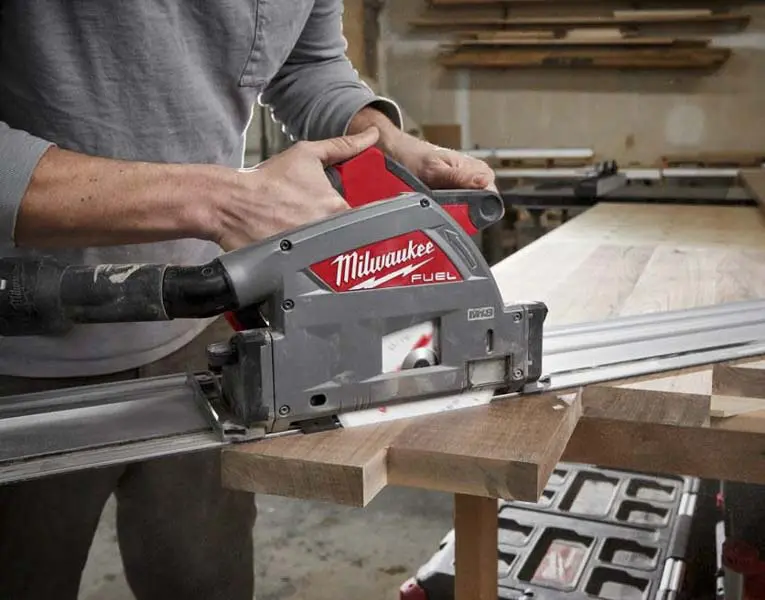
Milwaukee M18 Track Saw Kit 2831-21
- Type: Cordless
- Power: 18V
- Speed: Up to 6,300 RPM
The Milwaukee M18 2831-21 is one of the most powerful and advanced models on the market, even when compared to corded models. This model uses the Milwaukee M18 cordless battery lineup and it comes with a long-lasting 6.0ah battery and charger. The brushless motor can run the saw at speeds up to 6,300 RPM, making it the fastest on our list of the best track saws, though speed is adjustable for harder materials.
Here’s the deal: This kit, despite being relatively expensive, doesn’t come with any tracks. However, users will appreciate the power and the Redlink Plus technology which optimizes the saw’s performance and prevents it from reaching overload. And, the cam system that attaches the saw to the track is adjustable, allowing users to get extremely accurate, straight cuts.
Pros
- Runs on the powerful M18 battery lineup for plenty of capability
- Runs at speeds up to 6,300 RPM (fastest on the list)
- Brushless motor and Redlink Plus tech provide overload protection and optimal performance
Cons
- No notable drawbacks
Best Circular Saw Track System

Kreg Accu-Cut XL KMA3700
- Type: NA
- Power: NA
- Speed: NA
DIYers and pros looking to add functionality without buying a new saw should consider the Kreg Accu-Cut XL. This track and sled system allows users to turn any circular saw into a track saw. The sled is universal, allowing it to attach to any circular saw regardless of the side the blade is on, making this our choice for the best track saw system.
This kit comes with four 26.5-inch tracks, allowing customers to work with shorter, more manageable tracks, and they can link them together for longer work. However, understand that this kit doesn’t come with a circular saw and that a saw attached to the sled will not have a plunge function like a typical model.
Pros
- Very affordable way to get functionality without actually purchasing a new unit
- Universal sled fits any circular with the blade on either side
- Highly portable design allows users to take it anywhere they might need it
Cons
- It doesn’t come with a saw so users will have to supply their own
- The saw won’t plunge like a typical track saw
Our Process and the Nitty Gritty
- Why Trust Pro Tool Reviews
- How We Made Our Choices
- Other Recommendations from Brands We Trust
- What We Look for When Buying a Track Saw
- Track Saw Uses
- Safety Tips
- Frequently Asked Questions
Why You Can Trust Pro Tool Reviews
Ever check out a “review” site and you can’t tell if they actually tested the product or if they’re just “recommending” the Amazon top sellers? That’s not us. We won’t recommend anything unless we’d actually use it ourselves, and we don’t care who the primary retailer is. It’s all about giving you a legitimate recommendation and our honest opinion of each product.
Since 2008, Pro Tool Reviews has provided in-depth tool reviews, buying guides, how-to articles, and industry news in the construction and lawn care industries. We focus on professionals in the trades and our writers have the skills and experience to know whether a tool or accessory will hold up on the jobsite.
Each year, we bring in and review more than 250 individual products. Additionally, our team will put their hands on hundreds more tools at media events and trade shows throughout the year. If I recommend a work boot, that means I’d wear it myself (and perhaps I or one of our staff already does!)
How We Picked the Best Track Saw
Track saws aren’t cheap, but no precision-focused tool is. Knowing that it’s important that users get as much bang for their buck as possible but that the saw is still accurate, we worked hard to make sure the tools in this comparison were up to the task. We thought about all of our experiences using track saws, which features we liked, which we didn’t like, and which features we thought were absolute must-haves.
Once we knew which features we knew we needed to have, we started rounding up track saws from manufacturers we know and trust. Then, we started to compare these track saws closely. We compare them based on their features, power, the type of saw they were, the kits they came with, and their prices. We drew on our personal experience with these saws and considered users’ track saw reviews. This comparison revealed the following models as the winners.
Other Recommendations from Brands We Trust
Bosch Precision Saw with Plunge Action GKT13-225L

If you’re looking for options in addition to our top four picks, we suggest you take a look at the Bosch GKT13-225L. It’s a solid unit that has a few things worth writing home about. For instance, this track saw is powerful. In fact, its 6,250 RPM blade speed rivals the Milwaukee 2831-21, which was the fastest of our top picks.
And, related to power, the GKT13-225L has some noteworthy electronics–namely, its constant electronics feature, which helps maintain speed in heavier applications. Furthermore, a few mentionable design features include a swivel vacuum hose port, an easy-change blade system, and overload protection to guard against overheating.
Features
- Type: Corded
- Power: 13 amp
- Speed: 6,250 RPM
Pros
- Powerful
- Single-bevel pivot point
Cons
- A bit pricey, depending on your budget
DeWalt 60V MAX 6.5-Inch Track Saw DCS520ST1

No doubt, there isn’t any shortage of corded track saws on the market. That said, you might like another battery-powered option, and we think the Dewalt DCS520ST1 is worth considering. Certainly, DeWalt has become a trusted name among DIYers, Prosumers, and Pros alike.
Driving this model is a brushless motor and a 60V (6.0Ah) Flexvolt battery. You’ll have the cross-compatibility benefits that this platform offers. What’s more, the power that it delivers is nothing to sneeze at–blade speeds of up to 4,000 RPM. To put that into context, the DCS520ST1 can handle hardwoods up to 2-1/8 inches thick.
Ultimately, this unit is great for precise and clean rip, cross, and bevel cuts. Also, if you do a lot of inside work, you’ll appreciate the dust collection system, which we found works very well.
Features
- Type: Cordless
- Power: 60V (6.0Ah)
- Speed: 4,000 RPM
Pros
- Offers the portability of cordless
- Decent blade speed for a battery-powered model
- Comprehensive kit
Cons
- For intensive job site use, you’ll likely need a few batteries on hand (if you’re just starting with DeWalt, this will increase the price)
Makita 6-1/2″ Plunge Circular Saw Kit SP6000J1
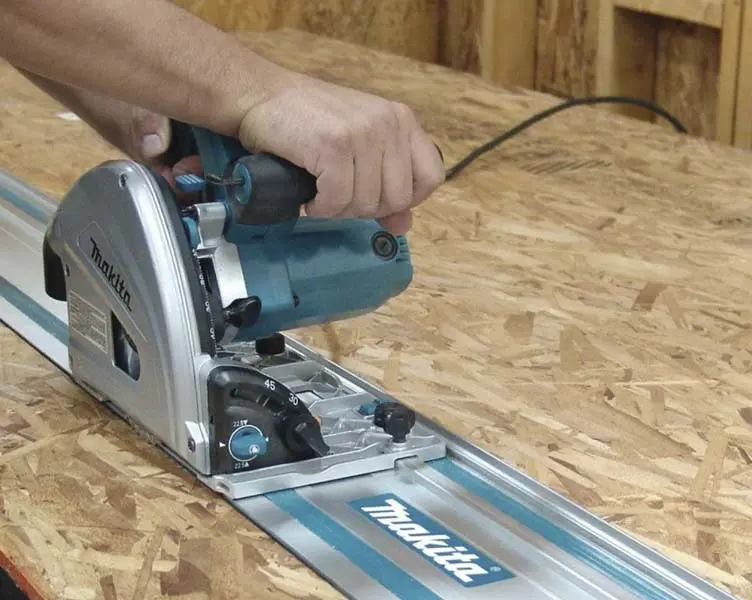
The Makita SPG600J1 is our choice for the best track saw for many reasons, and most shoppers will find it fits their needs. This track saw features a tech-rich motor. It has adjustable speeds that dial up and down between 2,000 and 5,200 RPMs. It also has electronic speed control to provide consistent speed while cutting and a current limit to prevent the motor from burning out. The saw also has an electronic brake to stop the blade when the trigger is released.
This saw features a 6 1/2-inch blade that can cut up to 2 3/16 inches deep. The saw bevels from -1 to 48 degrees, as well. The kit comes with a 55-inch track and a hard carrying case to keep the unit safe. However, the entire kit weighs over 15 pounds (16 1/2), so it might be an armful for some users. Also, it doesn’t come with clamps for the track, but that’s not necessarily a deal breaker.
Features
- Type: Corded
- Power: 12 amp
- Speed: 2,000 to 5,200 RPM
Pros
- Features adjustable speeds (with electronic speed control) that allow users to cut a wide variety of materials
- Cuts 2 3/16 inches deep and bevels up to 48 degrees
- Comes with a stackable carrying case for safe storage
Cons
- Total weight is over 15 pounds so it’s definitely an armful
- It doesn’t come with clamps
What We Look for When Buying a Track Saw
Track saws add a level of accuracy and convenience that most other tools cannot. But not just any saw can do the trick. The following are some of the most important considerations to process when choosing the best track saw.
Power and Performance
Motor Power
When it comes to corded track saws, power is determined in terms of amps. The more amperage a tool can handle, the more powerful it is and the better it can cool itself during heavy-duty use. Most compact track saws feature 10 to 12-amp motors.
When considering a cordless track saw, power is expressed in terms of volts. These tools use specific battery systems, such as 18V or 20V, and the more volts, the more powerful the motor. Amp hours, which are an expression of the battery capacity, are also an important factor, as the more amp hours, the longer the tool can run at full capacity. For a track saw, 3.0 or 4.0Ah batteries should be the minimum.
Speed Adjustments
Some track saws have adjustable speeds, which can be a big help when working with different materials. Rather than just spinning at a preset speed (such as 4,500 or 5,000 RPM), the user can adjust the saw to a lower speed (such as 2,000 RPM). Saws perform better at lower speeds when cutting hardwoods. However, for softer materials, higher speeds are often better.
Blade Quality and Types
Blade Size
Most track saws use a 6 ½-inch blade, which is sufficient for the types of cuts that a track saw can make. They can typically cut materials around 2 inches thick, making them useful for breaking down large slabs, trimming doors, or cutting two layers of plywood at once.
There are larger saws, as well, with blades measuring 8 ½ inches in diameter. These are mostly commercial tools, so they’re typically more expensive and difficult to find than a standard track saw.
Blade Change Mechanism
All blades dull eventually, and blade changes can be a pain. The best track saws will have levers that hold the saw’s blade in place, allowing the user to quickly loosen the bolt holding the blade to the spindle. This allows for quick, safe blade changes.
Track Length and Compatibility
Length Options
Shoppers should consider the length of the track they need when purchasing their track saw. People who break down large sheets of drywall will need longer tracks, often over 100 inches, to allow them to attach the saw and cut effectively. But a shorter track is typically fine—50 or so inches- if it is only for trimming doors.
Keep in mind that most track saw tracks can connect (if they’re from the same brand) to create one longer track. While this is convenient, be sure to check the tracks to ensure that they’re perfectly straight when connected before relying on them.
Another note to consider is that most tracks are aluminum, so they can be cut to length on a miter saw with a plywood blade inserted. Pros and DIYers can buy longer tracks and cut them to the length they need for their projects if desired.
Compatibility with Other Brands
Some track saws might be compatible with other brands. Also, there are tracks with brackets available so users can adapt their saw to work. This isn’t always the case though. Most of the time, tracks and track saws are specific to the brand, so shoppers need to be sure their saw will work with whatever track they purchase if they purchase them separately.
Ease of Use and Ergonomic
Handle Design
Handle design is quite important for a track saw because the user has to push the blade down into the material while also pushing it forward to cut. A D-shaped handle is the best for this as it offers the most control. Also, a handle at the front of the saw provides more control and stability while cutting.
Weight and Portability
Track saws, along with their clamps and tracks, are fairly heavy for a power tool (heavier than most circular saws). This isn’t a bad thing, as the added weight can provide more stability and less vibration while cutting. But, in general, a saw that weighs around 10 pounds will offer enough stability without being too heavy. But other than transporting it to and from the site or lifting it onto a shelf, weight shouldn’t be a major consideration.
Brand Reputation and Warranty
Customer Reviews
Some shoppers might find the peace of mind they’re looking for by checking out customer reviews. Learning more about what customers think of the tool can provide insight into what it’s like to work with, what the major complaints are, and whether or not it’s worth the money.
Brand Reputation
Track saws need to be accurate and powerful, and that can be hard for an inferior brand to accomplish. For that reason, we believe customers should choose saws from power tool brands with a reputation for building quality tools.
Warranty Length and Coverage
Power tool warranties are generally limited, which means that any misuse or lack of maintenance could void them. But, most reputable brands will provide a 1- to 3-year warranty with their power tools to ensure that customers are happy and get their money’s worth. If the saw fails due to a workmanship or material fault, the company will typically fix or replace the saw, or provide a credit to purchase a new one.
Uses of Track Saws
There are many uses for these tools. They’re handy tools that can be used for a lot of different reasons. The following are some of the most common uses for a track saw.
Cutting Long, Straight Lines
Sheet Goods
Breaking down sheet goods like plywood, project boards, MDF, HDF, particle board, and other materials that come in long, wide sheets is perfect for a track saw. These saws can clamp into place and the user can easily cut these sheets into boards or cabinet components, leaving behind clean, straight lines.
Boards and Panels
Similar to sheet goods, track saws can be used to rip boards to width easily and accurately. The same applies to paneling like wainscot and beadboard. They can also be used, in conjunction with a compatible jig or table, to true the ends of several boards at once, The user simply lines up the boards, drops the track in place, and cuts across the boards to create perfectly straight cuts.
Plunge Cuts and Internal Cutouts
Starting Cuts in the Middle of Material
Since track saws have to plunge into the material to cut, they’re ideal for starting cuts in the middle of a piece of material. In most cases, you can still use the track, and once it’s placed on top of the material, the user can easily and accurately press the saw down, lowering the blade into the material for an accurate plunge cut.
Cutting Windows and Doorways
Less commonly, contractors might use them to cut windows and doors out of sheathing. Working from the inside, the user will drill a screw through each corner, wrap a chalk line around the outside, and snap the line on the sheathing. After removing the screws, the user can lay the track on the marks and cut out the windows or doors.
Bevel and Miter Cuts
Adjusting the Blade Angle
Track saw users can adjust their blade’s angle to cut mitered angles. Most can bevel between 0 and 45 degrees. This allows the users to create long mitered joints on large pieces of material more easily than using a table saw.
Precision in Angled Cuts
Cutting a mitered angle across the face of a board needs to be accurate, which can be hard to accomplish with a circular saw. A track saw is a much better option, as the users can easily align the beginning and end points of the cut, trusting the saw will track straight across the points, ending up in a better cut.
Finishing Work
Trim Work
Finish carpenters and cabinet makers use track saws often. Whether it’s to cut a filler piece, trim a door, or cut in the field of a piece of material for several reasons, track saws can be very handy for finish and trim work.
Edge Banding
Folks who work with a lot of plywood can use a track saw to cut their edge banding. While this edge banding will be thicker than the common rolls of edge banding, the quality can be much better.
Safety Considerations When Using a Track Saw
As far as cutting tools goes, track saws are fairly safe, since the track helps to control the direction of the blade. But there are a few safety considerations to keep in mind.
Personal Protective Equipment (PPE)
Eye Protection
It’s always a good idea to protect your eyes when working with power tools. A track saw can send small chunks of material or splinters flying which can cause a lot of pain and injury if they land in the user’s eyes. For this reason, a pair of safety glasses that protect the eye but don’t obscure the user’s view is a must.
Hearing Protection
Track saws are just fancier circular saws, and they can be just as loud. A pair of ear muffs to protect the user from excessive noise is important to prevent damage or permanent hearing loss. Ear plugs can do the trick as well.
Dust Masks
Track saws typically have built-in dust collection ports, but they still make a lot of dust. Keep that airborne sawdust out of your mouth, nose, and airways to prevent breathing complications, reactions, and just general discomfort.
Safe Operation Practices
Proper Setup
Setting up the track saw is easy, but it needs to be done properly. The tracks should be slightly longer than the workpiece and clamped securely in place. Also, make sure that you have a clear path to walk as you cut the board. If you’re using a corded saw, be sure the cord won’t get caught as you’re cutting because the tug a cord can cause can impact accuracy.
Avoiding Kickback
Most track saws have anti-kickback devices that prevent them from tracking backward on the track. Make sure this is engaged on your saw. It usually requires the twist of a lever and lowering the saw completely onto the track. Once it’s on the track and snapped in, this mechanism will help prevent kickback.
Maintenance and Care
Blade Inspection and Replacement
Make sure to inspect the blade and the tool before each use. If the blade is dull, replace it. If the cord is frayed, do not use the saw. Look for any visible damage to the housing, safety features, and other parts of the saw.
Track and Guide Rail Maintenance
Inspect the track or guide rail to ensure that it’s clean, straight, and in good working condition. Bent or damaged tracks won’t result in straight cuts and can become dangerous to use when forcing the saw over the damaged area.
Don’t miss our Best Circular Saw and Best Cordless Circular Saw lists!
Frequently Asked Questions About Track Saws
Even though we’ve covered a lot of ground, some folks might have additional questions that need answering. The following are some of the most frequently asked questions about track saws.
What Makes a Track Saw Different from a Circular Saw?
When it comes to plunge saw vs circular saw, there are some distinct differences between the two:
- Track saws plunge into the material, while circular saw depths are preset before the cut.
- Track saws run along a guided track system while circular saws have beds or shoes that sit directly on the material.
- Track saw blades are typically enclosed while circular saw blades have swinging guards.
Can I Use a Track Saw Without the Guide Rail?
Yes, you can use a track saw without the guide rail to make plunge cuts in the middle of a piece of material. They’re not as convenient for long cuts without their tracks, however.
How Do I Choose the Right Blade for My Track Saw?
Your track saw can only use one size blade, which is usually 6.5 inches. Also, most jobs will call for a finish blade or a plywood blade.
Can Track Saws Make Bevel Cuts?
Yes, most track saws have adjustable angles that allow them to make bevel cuts.
How Do I Ensure Straight Cuts with a Track Saw?
Inspect your track to ensure that it’s straight and true. If not, replace it. Also, make sure there aren’t any obstructions under the saw when attaching it to the track, and be sure that it’s fully seated in the track before cutting.

